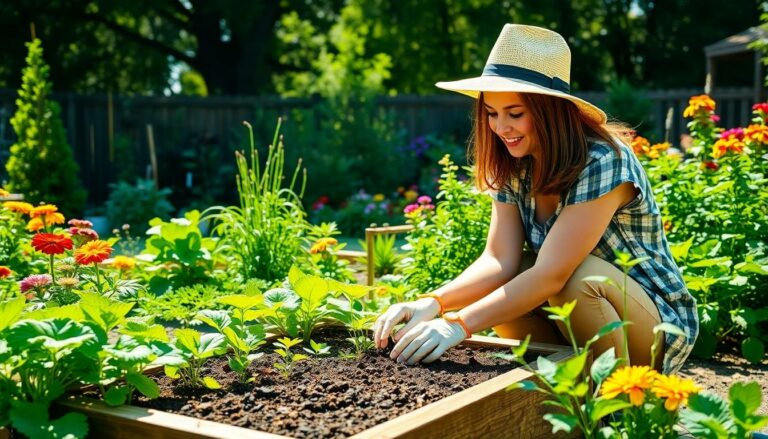Transforming your outdoor space doesn’t have to come at the expense of Mother Earth. In fact, with sustainable garden furniture, you can lounge in style while giving a high-five to the planet. Imagine sipping your morning coffee on a chair made from recycled materials or a table crafted from reclaimed wood. Not only does it look good, but it also feels good knowing you’re making eco-friendly choices.
sustainable garden furniture
Sustainable garden furniture consists of items designed with environmentally friendly materials and practices. This furniture type plays a crucial role in reducing ecological impact while enhancing outdoor spaces.
Definition And Importance
Sustainable garden furniture refers to products made from renewable resources, recycled materials, or reclaimed woods. Such materials minimize deforestation and waste. Emphasizing sustainability, these furnishings provide practical solutions for eco-conscious consumers. Choosing sustainable furniture contributes to a healthier planet by lowering carbon footprints. This choice offers durability and longevity, ensuring that outdoor spaces remain beautiful for years.
Benefits Of Sustainable Materials
Sustainable materials offer numerous advantages for garden furniture. They reduce reliance on non-renewable resources, promoting environmental balance. Recycled plastics and metals often require less energy to produce compared to traditional materials. Such products can withstand various weather conditions due to their durability, ensuring that they last longer. Eco-friendly materials often come with low emissions during production, improving air quality. These options frequently feature unique designs and craftsmanship, enhancing aesthetic appeal in outdoor settings.
Types Of Sustainable Garden Furniture

Various types of sustainable garden furniture are available, catering to eco-conscious consumers looking to enhance outdoor spaces. Each type offers unique benefits while contributing positively to environmental conservation.
Recycled Materials
Furniture made from recycled materials includes items crafted from repurposed plastics, metals, or glass. These materials reduce waste, diverting items from landfills and minimizing environmental impact. For instance, chairs and tables created from recycled plastic bottles often mimic the look of traditional materials while providing durability. Components derived from old furniture also serve as a fantastic option, allowing for creative designs that reflect an eco-friendly lifestyle. Furthermore, using recycled materials lowers production energy demands, making it a smart choice for those focused on sustainability.
Sustainably Sourced Wood
Sustainably sourced wood comes from forests managed to maintain ecological balance and biodiversity. Organizations certify such wood, ensuring responsible harvesting practices. Teak and eucalyptus are common choices, known for their natural resistance to weather and pests. Opting for furniture made with these woods supports responsible forestry. Additionally, reclaimed wood provides an aesthetic touch, offering unique textures and history that new materials lack. Sustainable sourcing contributes to lower carbon emissions associated with wood production, reinforcing environmental benefits.
Eco-Friendly Alternatives
Eco-friendly alternatives encompass materials like bamboo and hemp, which are rapidly renewable and often require minimal resources for production. Bamboo, for example, grows substantially faster than traditional hardwoods, making it a sustainable option for garden furniture. It possesses a high strength-to-weight ratio, ensuring durability while remaining lightweight. Hemp fibers also create sturdy textiles suitable for cushions and outdoor decor. Furthermore, items made with these alternatives help reduce reliance on conventional lumber, promoting a more sustainable outdoor environment.
Designing A Sustainable Garden
Creating a sustainable garden requires thoughtful integration of furniture with the natural environment to enhance outdoor beauty.
Integrating Furniture With Nature
Incorporate furniture that blends seamlessly with plants and surrounding landscapes. Natural materials, like reclaimed wood or bamboo, complement the garden’s organic elements. Consider positioning seating areas amid greenery to foster a sense of tranquility and connection to nature. Natural color palettes for furniture, like earthy tones, harmonize with blooming flowers and lush foliage. Wildlife-friendly features, such as butterfly-attracting plants near seating arrangements, enhance biodiversity while offering aesthetic appeal. Strive for a layout that encourages relaxation while promoting ecological balance.
Choosing The Right Style And Aesthetics
Selecting garden furniture should reflect personal taste while prioritizing sustainability. Minimalist designs often utilize fewer materials, simplifying care and creating an open atmosphere. Rustic styles, crafted from reclaimed wood, evoke charm and history, aligning well with eco-friendly practices. Opt for contemporary designs that incorporate recycled materials, providing modern appeal without sacrificing environmental responsibility. Coordinating colors and textures can create a cohesive visual theme, making outdoor spaces inviting. Include decorative elements, like cushions made from organic fabrics, to enhance comfort while maintaining eco-conscious values.
Maintenance Of Sustainable Garden Furniture
Maintaining sustainable garden furniture ensures its aesthetics and functionality remain intact over time. Proper care enhances durability and reflects commitment to eco-friendly choices.
Care Tips For Longevity
Regular cleaning keeps furniture looking its best. Use mild soap and water, avoiding harsh chemicals that could damage materials. Applying protective finishes, such as natural oils or sealants, increases resistance to weather elements. Storing furniture indoors or covering it during harsh weather prevents wear and decay. Periodic inspections for signs of wear or damage help address issues before they worsen. Keeping cushions dry and clean ensures comfort and longevity.
Repairing Vs. Replacing
Repairing offers a sustainable alternative to replacing damaged furniture items. Small scratches or dents can often be sanded or refinished, restoring original beauty. For broken pieces, many manufacturers provide replacement parts, extending the life cycle of products. Selecting high-quality materials initially increases the likelihood of successful repairs later on. Replacing furniture items should be a last resort, as each discarded piece adds to environmental waste. When replacements become necessary, opting for new sustainable options continues the cycle of eco-conscious living.
environmental responsibility
Embracing sustainable garden furniture is a step towards creating a beautiful and eco-friendly outdoor space. By choosing pieces made from recycled materials or responsibly sourced wood, individuals can enhance their gardens while minimizing environmental impact. The unique designs and durability of these furnishings not only elevate aesthetics but also promote a healthier planet.
Prioritizing maintenance and thoughtful design ensures that sustainable furniture remains a long-lasting investment. Each choice made contributes to a greener future, allowing everyone to enjoy nature without compromising its integrity. Making informed decisions about garden furniture can lead to a more sustainable lifestyle that resonates with personal values and environmental responsibility.




